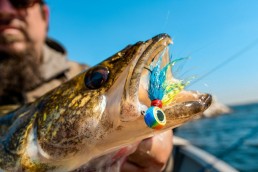Hair Today, Tinsel Tomorrow
|
Northland® Fishing Tackle’s refined & retuned blasts from the past that boat tons of fish |
|
BEMIDJI, Minn. (April 29, 2024) – Although new walleye fishing techniques are being developed all the time, savvy anglers are keen on digging through the past, rediscovering effective baits and methods that may have fallen out of the limelight. Like hair and tinsel jigs. Going back to World War II, a hair jig was included in most military survival kits. Why? They catch fish when you’d need it most, stranded and starving, waiting for rescue. That says a lot. Hair – either bucktail, marabou, or other fluff – has been used for decades upon decades of walleye runs, too. Same thing for tinsel. And guess what? They still catch fish today, something Northland wants to share with the walleye fishing public. Yes, everything old is new again – in the case of the Northland Deep-Vee Bucktail Jig and Deep-Vee Flashtail Jig – refined and retuned to catch even more fish than antique versions. We talked with some serious walleye sticks, and here are their thoughts on hair and flash for spring walleyes. Veteran Minnesota fishing guide, Brian “Bro” Brosdahl, offers: “Going way back, I’ve always been a fan of both hair and tinsel and have been catching a lot of fish in both clear and dirty water on the new Northland jigs. They have a slow fall and pull walleyes away from cover. Talking tinsel, I typically pitch the Deep-Vee Flashtail and work it on a slow retrieve with subtle twitches to create little flashes in different directions that look like minnows reflecting light.” |
|
|
Bro: How To Work A Hair Jig “The whole thing is the fall with hair and tinsel jigs,” says Bro. “There’s bulk to the bait so fish know it’s there, and the hairs and tinsel spread out in the water, and draw the fish in.” On rivers, Bro says, you want to carry some 3/8, ½, and even heavier jigs to deal with the current. “Cast out and hit the edge of a current seam and pull it in slowly. Upstream at 45 degrees gives you a great drop and drift down, and then the swing around downstream is a lot of times where you get bit.” Bro also likes to pitch shallower river riprap with lighter jigs, catching walleyes anywhere from right next to the bank to six feet of water. “I like fishing the Northland Deep-Vee Bucktail Jig and Deep-Vee Flashtail around wingdams, too,” says Bro. “A ¼- to 3/8-oz. is typical, and I’m focusing on odd structure where barges may have hit, or ice moved rock around. They’re walleye magnets. It’s not just the wingdam tip. You can catch them on top, the corners near shore, the tip, really all over. My Side Imaging and 360 help dial them in.” In terms of cadence around wingdams, Bro lets the jig fall, then makes short reel handle cranks, moving the rod only slightly. |
|
New Deep-Vee Flashtail (shown in FIRETIGER) |
|
“After it hits bottom, I give it a little pop, then reel and pause. Wingdam walleyes will hit it super hard. Works anytime walleyes are relating to wingdams.” Bro also likes to work both river and lake shorelines with the new jigs, orienting his boat parallel to the shore, and pitching up and down with the shoreline edge, distancing the jig at different depths – from right up close to deeper water nearby. “Again, I make an initial pop after the jig hits bottom, then work it upstream in the river. You can also slip the current instead of spot-locking or using Talons/Raptors. The deal is to get the hairs swimming and pulsing. Walleyes love willow cats (tadpole madtom) which are clumsy swimmers; they kind of move and flip side to side.” Looking forward to fishing lakes this MN Fishing Opener on May 11, Bro doesn’t always fish a plain Tungsten Jig and minnow. “A Deep-Vee Bucktail Jig or Flashtail tipped with a fathead or rainbow can be great for working flats and covering water around opener. You can pitch it right up to shore and around those walleye spawn and shiner run areas with current and catch a ton of fish. Gravel and weed transitions, too, as fish disperse toward the first breakline.” |
|
Deep-Vee Flashtail (BLACK) |
|
Deep-Vee Bucktail (PURPLEDESCENT) |
|
Deep-Vee Flashtail (MOONLIGHT) |
|
Deep-Vee Bucktail (PARROT) |
|
Hair Jig Color Does hair jig color matter? Some say yes, others say no. But know this: walleye vision is superb with their eyes containing retinal cells called tapedum lucidum that are optimized for telling them ‘is this something I want to eat?’ – even in lowlight situations. So, depending on how quickly you’re fishing a bait, color may indeed come into play. Obviously, matching predominant forage is always a good idea, but sometimes the silhouette created by a black, purple, or dark-colored hair jig is the ticket, too – not to mention darker colors can replicate willow cats, bullheads, and other bottom-dwellers walleyes eat. And combinations of colors, too, are always good to provide contrast, just like real minnows and young-of-the-year walleyes (yes, they’re cannibals), perch, etc. “I try different colors to see what works,” says Brosdahl. “I’ve always been kind of a blue & white, green & white, and Parrot kind of guy, but I’m loving purple, too. With zebra mussels, we have a lot of clear lakes now – and for whatever reason, purple has been hot.” BRO’S SET-UP
|
|
































